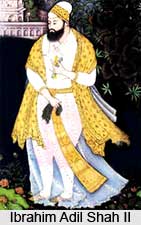 Ibrahim Adil Shah II was a famous Dhrupad singer from South India. In fact he was a king of Bijapur in the 14th-15th century AD. He was the son of Tahmaspa the younger brother of Ali Adil Shah I. From and early age Ibrahim Adil shah II was very fond of music. As a result of his experience in art and music, he earned the title of `Jagadguru`. It has been written in his memoirs by Jahangir that Bakhtar Khan was the teacher of Ibrahim Adil Shah II in Dhrupad. Ibrahim Adil Shah II wrote fifty-nine Dhrupads in seventeen Raagas. Of these nineteen Dhrupads are in Raaga Kanhada. It appears that Raaga Kanhada was Ibrahim`s favourite Raaga. The collection of Ibrahim Adil Shah II`s Dhrupads is known as Kitab-i-nauras of which nine manuscripts have so far been traced. This collection has been published with introduction, notes and textual editing by Nazir Ahmad.
Ibrahim Adil Shah II was a famous Dhrupad singer from South India. In fact he was a king of Bijapur in the 14th-15th century AD. He was the son of Tahmaspa the younger brother of Ali Adil Shah I. From and early age Ibrahim Adil shah II was very fond of music. As a result of his experience in art and music, he earned the title of `Jagadguru`. It has been written in his memoirs by Jahangir that Bakhtar Khan was the teacher of Ibrahim Adil Shah II in Dhrupad. Ibrahim Adil Shah II wrote fifty-nine Dhrupads in seventeen Raagas. Of these nineteen Dhrupads are in Raaga Kanhada. It appears that Raaga Kanhada was Ibrahim`s favourite Raaga. The collection of Ibrahim Adil Shah II`s Dhrupads is known as Kitab-i-nauras of which nine manuscripts have so far been traced. This collection has been published with introduction, notes and textual editing by Nazir Ahmad.
Ibrahim Adil Shah II mentions the Raaga of each Dhrupad but he does not mention the Talas in Dhrupad. In his Dhrupads he dealt with a variety of themes such as Hindu gods and Hindu goddesses, Muslim saints, Raaga Dhyanas (images of the Raagas) etc. Among these are Dhrupads in which he describes the virtues of his wife Chanda Sultan, his chief elephant Atasa Khan and his favourite musical instrument Moti Khan. Among the Hindu deities Goddess Saraswati and Lord Ganesha are frequently described. Ibrahim Adil Shah II was also a good player of the Veena.
In Kitab-i-Nauras, Ibrahim II has used the word Muqam for Raaga and the word Nauras for Dhrupad. His Dhrupads, as is true of all Dhrupads of this period, have only three Dhatus (pieces). Ibrahim Adilshah II did not introduce any novelty by composing Dhrupads of three Dhatus. He merely followed the order of his day. Most Dhrupads that are heard today have four Dhatus but this is because these are of a relatively later period.
It has been said by scholars, based on the Basatin-us-Salatin that Ibrahim Adilshah II had four thousand musicians in his court. Of these fourteen hundred were teachers and the rest were the pupils. Referring to the same, Nazir Ahmad says that there were three grades of musicians in Adil Shah II`s court. These grades were Huzuri, Darbari and Sahari. Huzuris were the highest in rank. They were the great musicians as well as learned scholars of musicology. Ibrahim Adil Shah II used to sing his Dhrupads before them to get their suggestions. Huzuris were in constant touch with Sultan Adil Shah II. The Darbaris were lower than the Huzuris. They were allowed to sit in Darbar and were taught by the Huzuris. The Saharis were even lower than the Darbaris and they lived in the city Nauraspur. They learnt music from Darbaris.
Adil Shah II`s contributions to music are immense. Not only was he himself a passionate and skilled Dhrupad singer and composer, but he was also a great patron of music. He collected a large number of musicians in his court and encouraged learned discussions on many detailed aspects of musicology in which he himself participated.




















